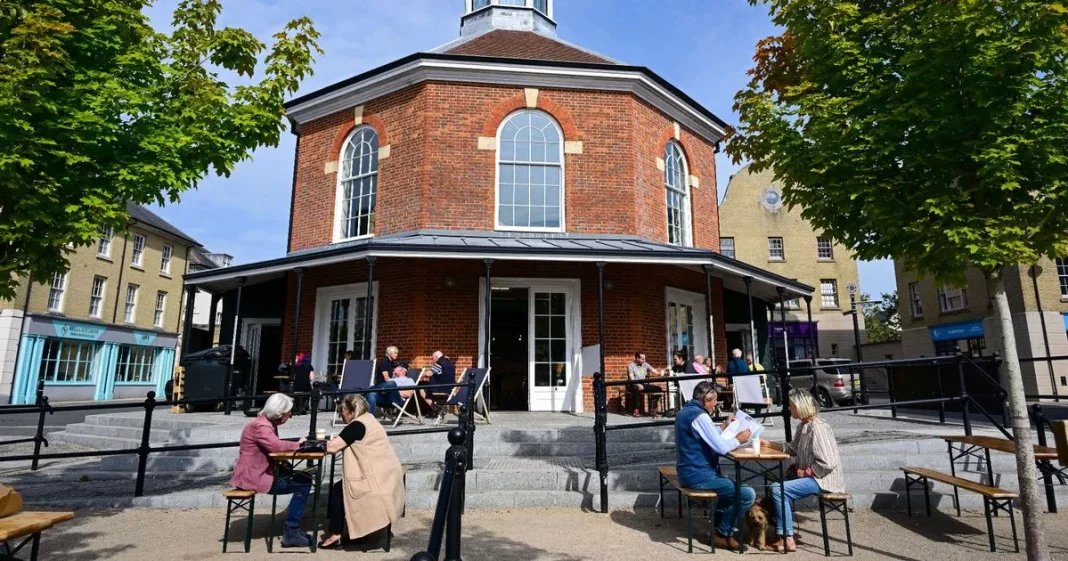The town of Poundbury was initially part of King Charles’ plan to create a “utopian idyll.” However, 40 years after the project began, critics have called it a “ghost town” and a “feudal Disneyland.” But what do the locals think?
The town is situated on Duchy of Cornwall land near Dorchester. Currently, it has around 2,320 homes, 4,600 residents, and 240 businesses employing 2,400 people. Poundbury is actually an urban expansion to Dorchester, started by the King in the late 1980s when he was the Prince of Wales and the Duke of Cornwall.
At the time, the King sought to challenge 20th century planning trends and policies, which had led to isolated housing estates and shopping centres away from places of work and leisure – forcing people to make more car journeys. The King previously described much of Britain’s modern architecture as an “unmitigated disaster” and a “monstrous carbuncle”.
Instead, Poundbury was to be built with a more sustainable approach in mind, using money from the Duchy of Cornwall charity. Luxembourg architect Léon Krier was commissioned to take on the project, starting with 400 acres of land.
It was designed to focus on the community where shops, places of work, and services are all within a 10 minute walking distance. It was also built to offer a mix of uses by “integrating homes with retail and other employment uses and public areas.”
Alongside homes, the town boasts infrastructure including a GP, dentist, school, and Post Office. Local businesses also include a garden centre, multiple coffee shops, a florist, a butcher, and two pubs – one of which is called the The Duchess of Cornwall in the town’s Queen Mother Square.
Poundbury also boasts some large green spaces, including the 30-acre Great Field, which has been planted with 400 trees and 26,000 shrubs. The King also wanted to build the town with a certain aesthetic, in addition to its functionality. The town features a mix of architectural styles, including Georgian, Victorian, Arts and Crafts, colonial, Dutch, and Venetian. It also has a wide range of housing types, including coach houses, terraces, industrial warehouses, mews houses, townhouses, villas, mansions, mansion blocks, and faux-converted barns.
The image of the town is a very important aspect of it, and there are strict rules for residents who want to decorate their homes. Those wanting to paint their house or door must only use colours from the Duchy of Cornwall’s “approved colour” list. Green-fingered households wanting to add a garden hedge to their gardens must choose an “appropriate Indigenous species” which must be “trimmed regularly”.
House signs must also be printed in one of the six permitted fonts, and the letters must be no more than 4cm high. Residents are also banned from listing their properties on sites such as Airbnb or Booking.com.
These strict rules have faced immense criticism since the town’s inception, with Poundbury being described as a “feudal Disneyland” and a “toy town.” The Guardian declared Poundbury “fake, heartless, authoritarian and grimly cute,” while Architectural writer Jonathan Meades was even more scathing, describing it as a “cottagey slum”, adding: “Thomas Hardy theme park for slow learners.”
However, others argue in support of uniformity as it helps integrate social housing with the rest of the community so there are no “poor doors”, according to one Poundbury resident. Overall, 35% of houses in the town are social housing.
So what is life like in Poundbury? – well the Daily Mail recently took a visit to the town and spoke to its residents. Eyre Maunsell has lived in the new town for three years and is almost boastful in his adoration for the place. He told the publication: “It’s great, and they’re still building it.”
“The traffic can be a nightmare but broadly it’s fine. Of course there’s no ball games, they sprinkle gravel on the tarmac, and of course there are no road signs as Charley boy hates them. But it’s wonderful.”
John and Susie Pearson have lived in the town for five years and claim that many of the estate’s negatives are overblown. Susie said, “Don’t look at anything written before! We can have washing lines! It’s wonderful living here. It’s like an expat community. Everyone wants to be friendly. You can walk everywhere.”
John added: “Ýes, 35% of the houses here are social housing, but you’d never know. It’s all perfectly mixed together.”
Susie noted that the gravel in the town is a “real problem.” In Poundbury, King Charles opted for a single layer of tarmac on all the town’s pavements supplemented with gravel so they could resemble the streets of Kensington and Chelsea. Susie added: “The people who come to put it on load it up with far too much and it goes everywhere. We have a pride in where we live though. That’s why we litter pick.”
The population of Poundbury is mostly made up of retirees. However, there are some young people knocking about who noted that the area was not the most happening of places and a lot of the time it felt like a bit of a “ghost town”. Ella Lakins, 21, told Mail Online: “I work here and live in Dorchester. I wouldn’t come here for a night out. There’s a few pubs but its not a young place. It is well known and respected, its more where people come and retire.”
Lola Wilkins, 18, added: “I quite like the aesthetic. It’s pretty, I’d live here.”
Another young man, Dan Bishop, who had grown up in the town but had moved away, said he “misses” it to this day. He said: “I grew up here. It was very quite and peaceful but its not suited for young people. I thought it was busy at the weekends but it isn’t really.
“The house prices are very high, there aren’t many first time buyers. The architecture is different.”
The royal project has not yet been completed, and the town continues to grow with another 350 homes in the Northern Quadrant due to be completed in 2026. The final section – based in the North West Quadrant – was granted planning consent in 2021. The building started in 2022 and is currently set to be completed in 2028.
According to the website: ‘Poundbury will have then increased the population of Dorchester by about a quarter, with an eventual community of approximately 5,800 people.’
Poundbury was named one of the “best places” to live in the UK by the Sunday Times last year, and the average price of a new-build home is around £400,000.
At Reach and across our entities we and our partners use information collected through cookies and other identifiers from your device to improve experience on our site, analyse how it is used and to show personalised advertising. You can opt out of the sale or sharing of your data, at any time clicking the “Do Not Sell or Share my Data” button at the bottom of the webpage. Please note that your preferences are browser specific. Use of our website and any of our services represents your acceptance of the use of cookies and consent to the practices described in our Privacy Notice and Cookie Notice.






